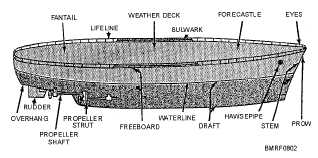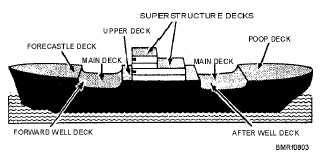The athwartships structure consists of transverse
frames and decks. The decks run outboard from the keel
to the turn of the bilge (where the bottom turns upward).
Here, they are attached to the transverse frames, which
then extend upward to the main deck.
Frames running parallel with the keel are called
longitudinals. From the turn of the bilge up the sides
they are also called stringers. The network of floors and
longitudinals resembles a honeycomb (known as
cellular construction), which greatly strengthens the
bottom of the ship. When plating covers the
honeycomb, double bottoms are formed. The space
between the inner and outer bottoms (known as tanks) is
used for liquid stowage. Planks laid upon the tank tops
are called ceilings. The forward end of the keel, which is
extended upward, is called the stem. The after end of the
keel has a similar extension called the sternpost. The
part of the stem above water is the prow; the forward
edge of the stem is the cutwater.
The interior of a ship is divided into compartments
by vertical walls, called bulkheads. Bulkheads run both
transversely and longitudinally. Most bulkheads are
merely partitions; but spaced at appropriate intervals,
they are transverse watertight bulkheads. These
bulkheads extend from the keel to the main deck and
from side to side to provide extra stiffening and to
partition the hull into independent watertight sections.
Large ships have a series of longitudinal side bulkheads
and tanks that provide protection against torpedoes.
Usually, the outer tanks are filled with oil or water, and
the inner tanks (called voids) are empty. The innermost
bulkhead is called the holding bulkhead. If a torpedo
were to hit the ship, the outer tanks, although ruptured,
would absorb enough energy from the explosion that the
holding bulkhead would remain intact, thus preventing
flooding of vital spaces.
The plates that form the ship’s hull are called
strakes. Strakes are fastened to the framework in
longitudinal rows. The keel forms the center strake.
Strakes are lettered, beginning with the A strake on
either side of the keel and extending up to the main deck.
Some of the strakes also have names. The A strake is
called the starboard strake; the strake along the turn of
the bilge is the bilge strake; the uppermost strake is the
sheer strake. A protecting keel running along the
bottom near the turn of the bilge is called a bilge keel. Its
purpose is to reduce rolling of the ship. (A ship rolls
from side to side; it pitches when it goes up and down
fore and aft; it yaws when the bow swings to port and
starboard because of wave action.)
The upper edges of the sides, where the sheer
strakes join the main deck, are called the gunwales
(rhymes with funnels). The foremost part of the ship,
where the gunwales join the stem, is known as the eyes
of the ship. The port and starboard quarters are located
where the gunwales curve inward to the sternpost.
The water level along the hull of a ship afloat is the
waterline. The vertical distance from the bottom of the
keel to the waterline is the ship’s draft. Freeboard is the
distance from the waterline to the main deck. Figures
8-2 and 8-3 show various parts of the hull and deck.
Decks
The floors of a ship are called decks. They divide the
ship into layers and provide additional hull strength and
protection for internal spaces. The undersurface of each
deck forms the overhead (never the ceiling) of the
compartment below. Compartments are the rooms of a
ship. Some compartments are referred to as rooms, such
as the wardroom, stateroom, and engine room.
8-3
Student Notes:
Figure 8-2.—The hull.
Figure 8-3.—The weather deck.



